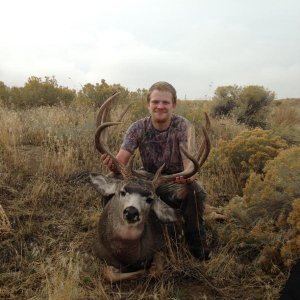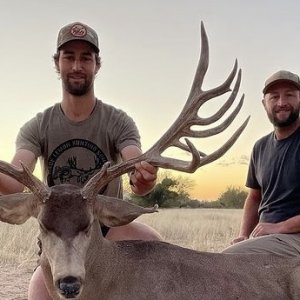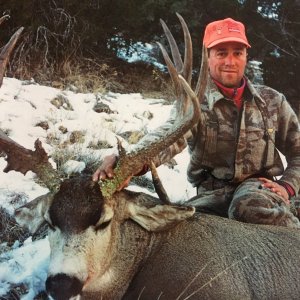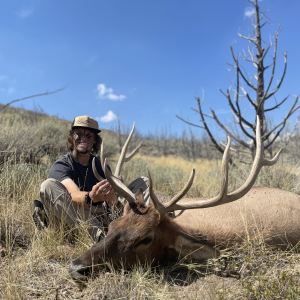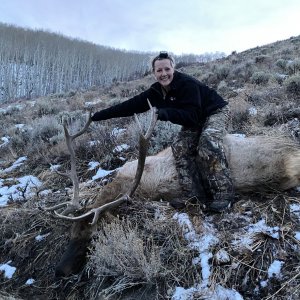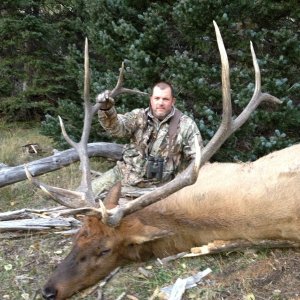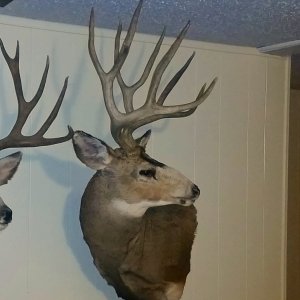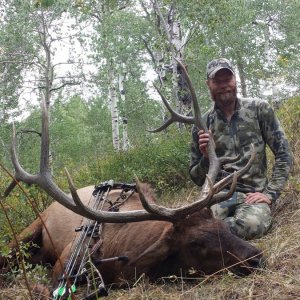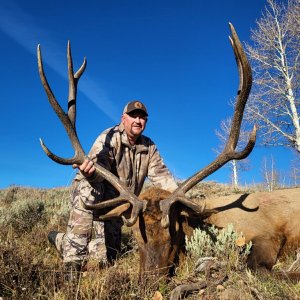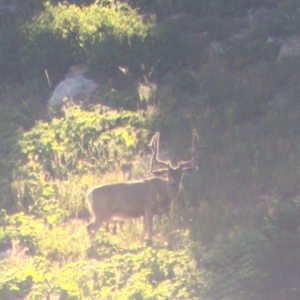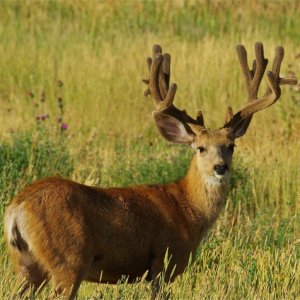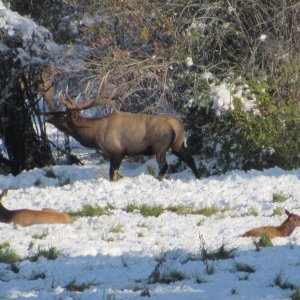Bowhunt, I don't know where you got your numbers but here is Yellowstones web site info....It's a little long but full of facts....
Elk (Cervus elaphus) are the most abundant large mammal found in Yellowstone; paleontological evidence confirms their continuous presence for at least 1,000 years. Yellowstone National Park was established in 1872, when market hunting of all large grazing animals was rampant. Not until after 1886, when the U.S. Army was called in to protect the park and wildlife slaughter was brought under control, did the large animals increase in number.
More than 30,000 elk from 7-8 different herds summer in Yellowstone and approximately 15,000 to 22,000 winter in the park. The subspecies of elk that lives here are found from Arizona to northern Canada along the Rocky Mountain chain; other species of elk were historically distributed from coast to coast, but disappeared from the eastern United States in the early 1800s. Some other subspecies of elk still occupy coastal regions of California, Washington, and Oregon. Elk are the second largest member of the deer family (moose are larger). Adult males, or bulls, range upwards of 700 pounds while females, or cows, average 500-525 pounds. Their coats are reddish brown with heavy, darker-colored manes and a distinct yellowish rump patch.
Bulls grow antlers annually from the time they are nearly one year old. When mature, a bull?s "rack" may have 6 to 8 points or tines on each side and weigh more than 30 pounds. The antlers are usually shed in March or April, and begin regrowing in May, when the bony growth is nourished by blood vessels and covered by furry-looking "velvet." Antler growth ceases each year by August, when the velvet dries up and bulls begin to scrape it off by rubbing against trees, in preparation for the autumn mating season or rut. A bull may gather 20-30 cows into his harem during the mating season, often clashing or locking antlers with another mature male for the privilege of dominating the herd group. By November, mating season ends and elk generally move to their winter ranges. Calves weighing 25-40 pounds are born in late May or early June.
Climate is the most important factor affecting the size and distribution of elk herds here. Nearly the whole park - approximately 2.2 million acres - provides summer range for elk. However, winter snowfalls force elk and other ungulates to leave the greater part of the park. Only the northern, lower-elevation portion of Yellowstone, where temperatures are more moderate and snowfall less than in the park interior, can support large numbers of wintering elk. Annual precipitation, which occurs mostly as snow, averages as high as 75" in the southern, high-mountain plateaus of the park; minimum temperatures there are often well below 0? F, and have been as low as -66? F. In contrast, most of the northern range averages less than 30" of precipitation annually, and winter temperatures are considerably warmer.
The Overgrazing Controversy
National attention has been focused on Yellowstone's northern elk winter range since the early 1930s. Scientists and managers then believed that grazing and drought in the early part of the century had reduced the range's carrying capacity, and that twice as many elk were on the range in 1932 as existed in 1914. From 1935 to 1968, elk, pronghorn, and bison numbers were artificially controlled by shooting or trapping and removal by park rangers. Then in the 1960s, based on new studies that suggested ungulate populations could possibly be self-regulating, elk reductions were discontinued in the park. The belief that elk grazing was damaging to northern range vegetation and that grazing accelerates erosion, although not supported by research data and analysis, has continued to the present. Studies of the northern elk winter range began in the 1960s and revealed no clear evidence of range overuse (Houston 1982). More recent studies conclude that sagebrush grasslands of Yellowstone's northern winter range are not overgrazed (Singer and Bishop 1990). In fact, plant production was enhanced by ungulate grazing in all but drought years. Protein content of grasses, yearly growth of big sagebrush, and seedling establishment of sagebrush were all enhanced by ungulate grazing. Neither reduction in root biomass nor an increase in dead bunchgrass clumps was observed. However, many questions remain concerning the condition of riparian zones and associated shrubby vegetation; the park hopes to conduct additional studies on aspen and willows and their relationship to ungulates on the northern range.
Two reports were made available in 1997, discussing at length the issue of grazing levels and other influences on Yellowstone's northern range. Yellowstone's Northern Range: Complexity and Change in a Wildland Ecosystem discusses the history of research and management in northern Yellowstone, home to one of the world's largest herds of elk and long the subject of controversy. Effects of Grazing by Wild Ungulates in Yellowstone National Park contains 22 technical publications summarizing recent research studies that have been peer-reviewed by scientists. Much of the research was completed by scientists from agencies other than the National Park Service, by independent contractors, and by scientists from universities located across the United States. For a copy of either report, contact the Yellowstone Center for Resources, Box 168, Yellowstone NP, Wyoming 82190, or call (307)344-2203.
Other Influences on Yellowstone's Elk Populations
Over-winter calf mortality, yearling mortality, and adult bull mortality all increase with higher elk population densities. Studies show that summer predation by grizzly bears, coyotes, black bears, and golden eagles takes an average of 32% of the northern range elk calves each year. Mountain lions prey upon elk, as do hunters north of the park (taking about 10% of the northern herd annually through the 1980s).
Gray wolves, eliminated from the park by the 1930s, are being restored, but not because park managers think the wolves will "control" the number of elk. Instead, 15 North American wolf experts predicted that 100 wolves in Yellowstone would reduce the elk by less than 20%, 10 years after reintroduction. Computer modeling of population dynamics on the northern winter range predicts that 75 wolves would kill 1,000 elk per winter, but that elk would be able to maintain their populations under this level of predation, and with only a slight decrease in hunter harvest. Since the restoration of wolves to Yellowstone began in January 1995, scientists have begun to document the effects of wolves on elk and other species. Wolves are preying predominantly on elk, as expected. They have also occasionally preyed upon moose, bison, deer, and even one pronghorn antelope.
The carrying capacity of the northern winter range increased in the 1980s because elk colonized new winter range in and north of the park, wet summers resulted in better plant production, winters were mild, and the fires of 1988 opened forests allowing more ground cover to grow. Since 1985, more than 11,000 acres of elk winter range have been purchased by the State of Montana and the U.S. Forest Service north of the park, increasing elk carrying capacity and reducing conflicts between native wildlife and agriculture.
The Madison-Firehole Herd
The Madison-Firehole elk herd has been the focus of research by Dr. Bob Garrott of Montana State University since November 1991. This herd numbers from 650-850, and is believed to winter almost entirely within Yellowstone Park. The population appears to be naturally regulated to a degree not found in other, human-hunted elk herds. The information resulting from this research is useful in comparing unhunted and hunted elk populations. Researchers examined the effects of environmental variability on ungulate reproduction and survival. Researchers also examined elk use of areas burned in the wildfires of 1988. Observations indicated that elk have made more than casual use of burned trees; tests showed that fires altered the chemical composition of lodgepole pine bark, making it more digestible and of higher protein content than live bark. While the burned bark was not the highest quality forage for elk, it is comparable to other low quality browse species. The researchers speculated that elk select burned bark because it is readily available above the snow cover in winter.


